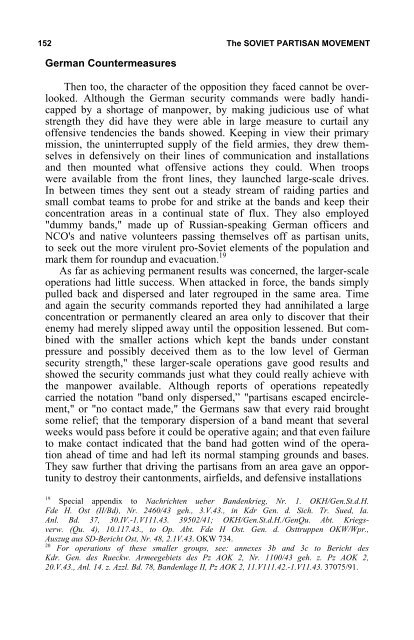the soviet partisan movement 1941-1944 by edgar m. howell
the soviet partisan movement 1941-1944 by edgar m. howell
the soviet partisan movement 1941-1944 by edgar m. howell
Create successful ePaper yourself
Turn your PDF publications into a flip-book with our unique Google optimized e-Paper software.
152 The SOVIET PARTISAN MOVEMENT<br />
German Countermeasures<br />
Then too, <strong>the</strong> character of <strong>the</strong> opposition <strong>the</strong>y faced cannot be overlooked.<br />
Although <strong>the</strong> German security commands were badly handicapped<br />
<strong>by</strong> a shortage of manpower, <strong>by</strong> making judicious use of what<br />
strength <strong>the</strong>y did have <strong>the</strong>y were able in large measure to curtail any<br />
offensive tendencies <strong>the</strong> bands showed. Keeping in view <strong>the</strong>ir primary<br />
mission, <strong>the</strong> uninterrupted supply of <strong>the</strong> field armies, <strong>the</strong>y drew <strong>the</strong>mselves<br />
in defensively on <strong>the</strong>ir lines of communication and installations<br />
and <strong>the</strong>n mounted what offensive actions <strong>the</strong>y could. When troops<br />
were available from <strong>the</strong> front lines, <strong>the</strong>y launched large-scale drives.<br />
In between times <strong>the</strong>y sent out a steady stream of raiding parties and<br />
small combat teams to probe for and strike at <strong>the</strong> bands and keep <strong>the</strong>ir<br />
concentration areas in a continual state of flux. They also employed<br />
"dummy bands," made up of Russian-speaking German officers and<br />
NCO's and native volunteers passing <strong>the</strong>mselves off as <strong>partisan</strong> units,<br />
to seek out <strong>the</strong> more virulent pro-Soviet elements of <strong>the</strong> population and<br />
mark <strong>the</strong>m for roundup and evacuation. 19<br />
As far as achieving permanent results was concerned, <strong>the</strong> larger-scale<br />
operations had little success. When attacked in force, <strong>the</strong> bands simply<br />
pulled back and dispersed and later regrouped in <strong>the</strong> same area. Time<br />
and again <strong>the</strong> security commands reported <strong>the</strong>y had annihilated a large<br />
concentration or permanently cleared an area only to discover that <strong>the</strong>ir<br />
enemy had merely slipped away until <strong>the</strong> opposition lessened. But combined<br />
with <strong>the</strong> smaller actions which kept <strong>the</strong> bands under constant<br />
pressure and possibly deceived <strong>the</strong>m as to <strong>the</strong> low level of German<br />
security strength," <strong>the</strong>se larger-scale operations gave good results and<br />
showed <strong>the</strong> security commands just what <strong>the</strong>y could really achieve with<br />
<strong>the</strong> manpower available. Although reports of operations repeatedly<br />
carried <strong>the</strong> notation "band only dispersed,” "<strong>partisan</strong>s escaped encirclement,"<br />
or "no contact made," <strong>the</strong> Germans saw that every raid brought<br />
some relief; that <strong>the</strong> temporary dispersion of a band meant that several<br />
weeks would pass before it could be operative again; and that even failure<br />
to make contact indicated that <strong>the</strong> band had gotten wind of <strong>the</strong> operation<br />
ahead of time and had left its normal stamping grounds and bases.<br />
They saw fur<strong>the</strong>r that driving <strong>the</strong> <strong>partisan</strong>s from an area gave an opportunity<br />
to destroy <strong>the</strong>ir cantonments, airfields, and defensive installations<br />
19<br />
Special appendix to Nachrichten ueber Bandenkrieg, Nr. 1. OKH/Gen.St.d.H.<br />
Fde H. Ost (II/Bd), Nr. 2460/43 geh., 3.V.43., in Kdr Gen. d. Sich. Tr. Sued, Ia.<br />
Anl. Bd. 37, 30.IV.-1.V111.43. 39502/41; OKH/Gen.St.d.H./GenQu. Abt. Kriegsverw.<br />
(Qu. 4), 10.117.43., to Op. Abt. Fde H Ost. Gen. d. Osttruppen OKW/Wpr.,<br />
Auszug aus SD-Bericht Ost, Nr. 48, 2.1V.43. OKW 734. <br />
20<br />
For operations of <strong>the</strong>se smaller groups, see: annexes 3b and 3c to Bericht des<br />
Kdr. Gen. des Rueckw. Armeegebiets des Pz AOK 2, Nr. 1100/43 geh. z. Pz AOK 2, <br />
20.V.43., Anl. 14. z. Azzl. Bd. 78, Bandenlage II, Pz AOK 2, 11.V111.42.-1.V11.43. 37075/91.
















